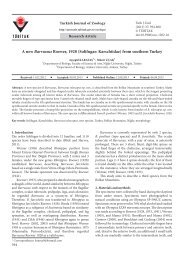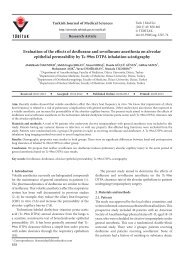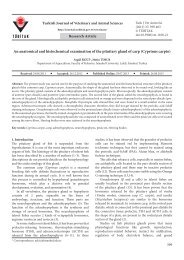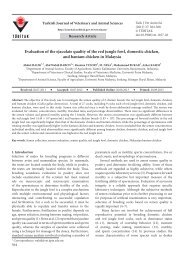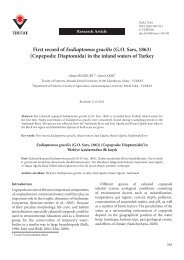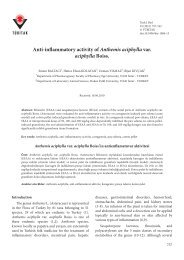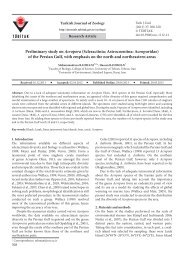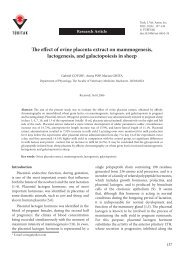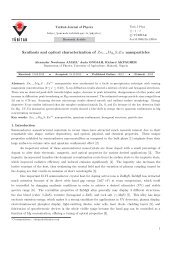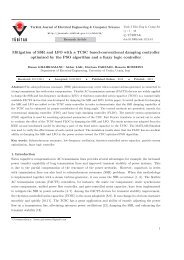Messinian forced regressions in the Adana Basin: a near ... - Tübitak
Messinian forced regressions in the Adana Basin: a near ... - Tübitak
Messinian forced regressions in the Adana Basin: a near ... - Tübitak
Create successful ePaper yourself
Turn your PDF publications into a flip-book with our unique Google optimized e-Paper software.
5.1.3. Bottomset facies<br />
The basal deltaic facies are only locally exposed, but are<br />
generally similar. The gently <strong>in</strong>cl<strong>in</strong>ed delta-toe deposits<br />
(Figures 4a and 6) are th<strong>in</strong>ly bedded, f<strong>in</strong>e-gra<strong>in</strong>ed<br />
sandstones and siltstones with plane-parallel stratification<br />
and m<strong>in</strong>or ripple cross-lam<strong>in</strong>ation. Delta bottomset<br />
consists of th<strong>in</strong> siltstone and sandstone beds <strong>in</strong>tercalated<br />
with mudstones (Figure 6). The microfauna content of<br />
<strong>the</strong>se deposits is described <strong>in</strong> a subsequent section.<br />
5.2. Incised valley-fill deposits<br />
This facies assemblage is exposed <strong>in</strong> a chance crosscut<br />
section <strong>in</strong> <strong>the</strong> proximal part of <strong>the</strong> Muratlı Member<br />
(Figures 1c and 5), but similar unexposed deposits<br />
presumably also occur <strong>in</strong> <strong>the</strong> 2 o<strong>the</strong>r coeval deltaic members<br />
8<br />
ILGAR et al. / Turkish J Earth Sci<br />
A B<br />
C<br />
1 m<br />
E F<br />
Figure 3. <strong>Mess<strong>in</strong>ian</strong> evaporites <strong>in</strong> <strong>the</strong> <strong>Adana</strong> Bas<strong>in</strong>. (a) An example outcrop of <strong>the</strong> evaporites at<br />
<strong>the</strong> top of Handere Formation. (b) Enterolithic gypsum. (c) Crystall<strong>in</strong>e gypsum with a chevron<br />
growth structure. (d) Crystall<strong>in</strong>e gypsum with a grassy growth structure. (e) Nodular gypsum.<br />
(f) Gypsarenite with wave-ripple cross-lam<strong>in</strong>ation. The co<strong>in</strong> (scale) is 2 cm.<br />
D<br />
of <strong>the</strong> Handere Formation, where no similar transverse<br />
sections are available. These deposits are recognisably<br />
coarser-gra<strong>in</strong>ed, compris<strong>in</strong>g pebble conglomerates and<br />
subord<strong>in</strong>ate coarse-gra<strong>in</strong>ed sandstones with scattered<br />
cobbles and boulders (Figure 5). Conglomerates are clastsupported,<br />
with a matrix of medium to coarse sand and<br />
granules. Gravel clasts are moderately sorted, ma<strong>in</strong>ly<br />
subangular to subrounded, and of <strong>the</strong> same provenance<br />
as <strong>the</strong> delta gravel. Scattered boulders are derived from<br />
<strong>the</strong> bas<strong>in</strong>-marg<strong>in</strong> Miocene reefal limestones. The deposits<br />
form erosionally based, vertically stacked f<strong>in</strong><strong>in</strong>g-upwards<br />
bedsets (Figure 5) <strong>in</strong>terpreted to be multistorey braidedstream<br />
palaeochannels (Coll<strong>in</strong>son 1996; Miall 1996),<br />
ma<strong>in</strong>ly 0.8–1.6 m thick and 10–25 m wide. Coarse gravelly<br />
channel-floor lags are poorly developed, but solitary



